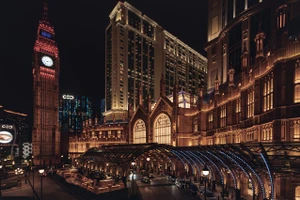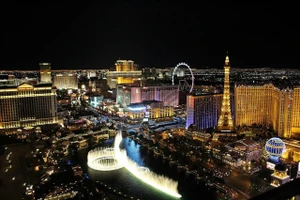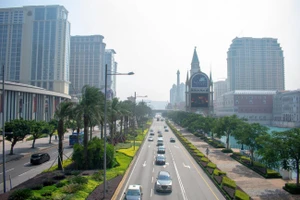Premium players and spectacle seekers underscore competing trends amid junket and money transfer crackdowns writes Muhammad Cohen.
It’s been three years since the arrest of Suncity chairman Alvin Chau lowered the boom on Macau junket promoters. Combined with Covid, Beijing’s dual crackdown on overseas gambling and illegal money movements plus authorities’ drive to diversify the economy away from Macau casinos have triggered huge changes across the Asian gaming landscape.
VIP play, once more than 70% of Macau’s total gaming revenue, US$29.8 billion in 2013 and halved to $14.2 billion in 2019, will total $3.3 billion this year, Morgan Stanley Asia managing director Praveen Choudhary estimates. Overall, Choudhary forecasts Macau’s total gaming revenue at $28.4billion, 22% below $36.2 billion in 2019 and 37% below the 2013 all-time high of US$45.1 billion. It’s a similar story for China-facing destinations across Asia in this post-Covid period.
Casino operators are adjusting to market realities – a process that began a decade ago when China’s policy directions became clear – but much remains to be done.
Trendy paradoxes
“Quite a bit has changed,” Platinum Consulting Group managing director Mary Mendoza says. The Macau based marketing specialist’s observations highlight two seemingly paradoxical trends.
“You have lot of mass market tourists, but they’re spending less. They take pictures, cruise for free stuff and then go back to hotels in Zhuhai and Hengqin,” the mainland China island a stone’s throw from Cotai.
On the other hand, Mendoza says, “On the mass floor, you don’t see many low limit tables under HK$1,000 (US$128).” Operators’ strategy, she says, is moving lower level players to electronic table games to keep live tables for rated players or players that can become rated.
That trend fits what Seaport Research Partners senior analyst Vitaly Umansky dubs the “premiumisation of Macau and its customer base.”
For example, Sands China rebranded Sands Cotai Central, opened in 2012, as The Londoner Macao, across the street from its Venetian and Parisian counterparts.
Bland to glam
“Renovations converted Londoner from a bland property that no one really wanted to go to,” Umansky says. “There wasn’t a lot of spend going on at that property.” He notes that Sands Cotai Central had more hotel rooms than Venetian Macao and nearly as much gaming space but generated a fraction of the revenues.

“Now that property has become more sticky,” Westar Architects principal Paul Heretakis says of Londoner. “If you’re only in Macau for a short period of time, and you might only visit half or a third of the properties, [Londoner] has become one of the ones you would visit now.”
On the lodging side, Sands Cotai Central’s conversion to Londoner includes upgrading the Holiday Inn and Sheraton hotels to Londoner and Londoner Court with larger rooms and higher suite counts. When completed, the renovations will reduce the number of keys by more than 25%, from 6,000, initially envisioned to support Sands’ US developed convention based integrated resort concept, to fewer than 4,500.
“Trading up on product quality, sometimes at the expense of volume, appears to be a common competitive strategy across the leading integrated resort operators in Macau over the past three-four years in particular,” former Galaxy Entertainment and Sands China executive Kevin Clayton says.
“That’s most likely to be in response to increasing demands and preferences of higher value customers, particularly in the premium gaming and premium leisure segments, and while MICE is an important sector for most operators and the Macau government, it’s not yielding anything like the expected volumes some 10 years ago.”
Beyond value tourism
“Mass tourism should not be confused with value-oriented tourism,” Klebanow Consulting principal Andrew Klebanow says. “The new [Londoner Grand] suite product will allow Sands to command a higher average daily rate and attract visitors who are not price sensitive. Those new visitors will also spend more on retail, dining, and gaming.
“There will always be a value lodging option in Macau, just not at the Londoner.”
Premiumisation is succeeding at some levels in Macau casinos. Mass gaming spending through October was 12% ahead of 2019, with higher per capita growth. According to Macau’s Statistics and Census Service, visitor non-gaming spending (in constant dollars) for the first three quarters of 2024 is 7.5% higher than 2019, despite 16.5% fewer visitors.

Per capita non-gaming spend is 29% higher. Year-on-year those figures are down by 6% and 15% respectively, casting a pall over retail in particular, despite the broader positive trend.
With non-gaming spend for the first nine months of US$7 billion alongside its US$21 billion gaming revenue, non-gaming accounts for roughly 25% of Macau visitor spending (Macau citizens’ gaming notwithstanding). While that non-gaming spend represents a major uptick from pre-pandemic levels that strained to reach double digits, it’s a far cry from Las Vegas, where two-thirds of revenue comes from non-gaming. Also note that Macau’s non-gaming progress stems in part from reduced gaming spend.
Most telling, perhaps, combined 2024 EBITDA for Macau concessionaires of US$8.1 billion will be 18% below 2019, as estimated by JP Morgan head of Asia gaming and leisure research DS Kim, though margins have improved slightly.
Disneyland in the distance
“The government may want to turn Macau into Disneyland, but that’s not where revenues and profits lie,” GamePlan Consultants founder and CEO Sudhir Kalè says. “In my lifetime, Macau will always be a gambling-centric destination and all operators know that.”
Macau has a long way to go to create a non-gaming ecosystem to meet public policy aspirations. “Las Vegas has 220,000 theater, sports and entertainment seats. In Vegas, sports, entertainment and conventions fill Las Vegas hotel rooms consistently,” Steelman Partners CEO Paul Steelman says. “Once Macau continues with the diversification plan, the entertainment in the city will require additional hotel rooms.”
On the gaming side, Steelman says, “A casino designed for Saturday night, which was every night in early Macau, will not be designed and constructed. Many large casinos, particularly the Venetian Macao, which spans over 50,000 square meters, will need to be reimagined to incorporate non-gaming attractions both at the edges and in the center of the gaming floor.”
Non-gaming roundabout
One template: Resorts World Genting’s Bar 360 featuring entertainment at the center of the main gaming floor. Genting brought the concept from Malaysia to Manila’s first IR as a partner in the predecessor to Newport World Resort and to its Resorts World New York City and RW Catskills properties. The latter IR in New York’s famed Borscht Belt also features SportsBook 360, with betting counters and kiosks, plus monitors to follow the action, arranged around a bar.

“Gaming should be viewed as a complementary activity that thrives alongside other attractions, not surrounded by four walls or a gaming room,” Steelman says.
“Asian casinos typically consist of integrated blocks of space, combining casinos, retail malls, and hotels. These elements need to be seamlessly integrated and stratified to guide non-gaming activities toward different levels of gaming. For instance, buffets can cater to the mass market, while signature restaurants, such as [Wynn Resorts’] SW Steakhouse or Delilah’s, can serve high-end clientele.”
Gladiators of the felt
Steelman notes, “An important trend to consider is the changing preferences of younger Asians, who are increasingly seeking Las Vegas-style vacations filled with diverse activities. They are less likely to be all-night gamblers who eat a quick bowl of noodles and continue playing.
“When we designed the Sands [Macao] in 2003, we embraced the idea that gambling is a sport for Asians, whereas it is viewed as entertainment for Westerners. This distinction is crucial in shaping the future of gaming and hospitality in these markets.

“Younger Asian gamblers will probably still consider gaming a sport, but will demand a more complete experience similar to Las Vegas.”
The renowned resort architect says, “Sports events, conventions, and large theatrical experiences are essential, but modern facilities also need to deliver Instagram-worthy moments. Our Digital Street [an image extravaganza – think of Fremont Street Experience in downtown Las Vegas – in Incheon at Mohegan Gaming’s] Inspire Aurora has been a tremendous success, attracting 20,000 visitors and generating 1,000 social media posts daily. Macau casinos must embrace this kind of creative, artful thinking to attract new customers and extend guest stays.”
Cash conversion
A formidable hurdle Mendoza identifies is ensuring those social media posters are also paying customers.
“Those IR operators, including hotel partners embedded in a resort, that continuously advance operating brand standards so the resort brand is synonymous with a set of premium experiences will more likely lead the market by revenue and EBITDA,” Clayton, a Mohegan Inspire Entertainment director, says. “These IR experiences in themselves are at the forefront of marketing when they are shared by customers’ with friends and family.”
“When Macau casinos were very, very popular and you had a huge VIP customer base, a lot of other levels and facets of the business were ignored,” Heretakis says. “You need to start to go after those segments.”
That can begin with something as simple as guiding guest movement. “It is imperative to undertake a comprehensive spatial reconfiguration that enhances both accessibility and flow,” Nikau Design Group managing director Nicola Greenaway says. “This involves the strategic delineation of gaming areas, the augmentation of seating and amenity provisions, and the implementation of sophisticated signage systems and way-finding to facilitate navigation.
“Integrating technology to monitor real time game availability and ensuring robust staff allocation will significantly enhance the overall player experience, fostering a more engaging and efficient gaming environment.”
Crazy eights
Technology can also significantly enhance understanding of player behavior. “Improved player tracking systems allow casinos to appropriately track carded as well as uncarded players,” Kalè says. “Rating systems using dealer or pit boss discretion are inherently flawed.
“For example, in a recent trip to the Horseshoe in Las Vegas, I dropped around four grand in three days. And guess what? My comps earned were around eight dollars!
“This would never happen with table tracking systems as each bet would be tabulated and the punter is rewarded based on their bets and the resultant theo[retical daily loss].”
The marketing PhD adds, “Player points, to me involve ‘earn and burn.’ Loyalty, on the other hand, encompasses both behavioral loyalty as well as attitudinal loyalty. Attitudinal loyalty has to be earned and cannot be purchased with points awarded to players. It is the outcome of a compelling customer experience.”
Strategic rebalancing at Macau casinos
“Mass market gaming necessitates a more balanced approach to promotional strategies,” Mendoza, whose resume includes stints at Sands China and Vietnam’s Hoiana, says. “Casinos often allocate a smaller percentage of revenue for reinvestment in mass market segments compared to high-value players.”
“While promotional expenses have been growing as the industry continues to shift away from VIP junket play and compete for mass market and premium mass customers, those marketing expenses remain far lower than the commissions that casinos once paid to junket promoters,” Klebanow says.
Mendoza’s research indicates gaming incentives such as free play or match play are yielding diminishing returns, so operators need to expand their promotional horizons. She suggests tournaments and lucky draws “to create excitement and engagement” on the gaming floor, as well as promotions combining gaming with non-gaming attractions such as entertainment or a host destination sightseeing treasure hunts.
“First to market exclusive retail product launches work well as headline attractions, particularly if these are thematic in-property installations providing a unique photo opportunity for social media,” Clayton says.
“Events like food festivals or wine tastings paired with gaming also draw in tourists looking for a comprehensive experience, making casinos more than just gaming venues but vibrant social hubs,” Mendoza says. “This multifaceted approach helps to cater to varying interests and preferences among visitors.”
“In Las Vegas, 40% of hotel rooms are marketed directly to known customers using the casinos’ highly valuable customer databases,” Steelman says. “Asian casinos should adopt a broader strategy, shifting their focus beyond just attracting high volumes of gamblers to cultivating and retaining high value customers.”
“Macau was a very special place for a period of time where it was just seeing incredible amounts of money,” Heretakis says. “It”s a more competitive market environment now, more like most environments around the world.”



